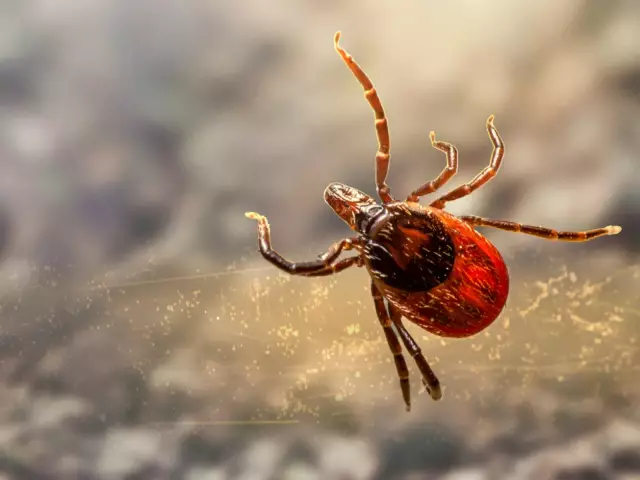- Author Rachel Wainwright [email protected].
- Public 2023-12-15 07:39.
- Last modified 2025-11-02 20:14.
10 myths about ticks and encephalitis
Tick-borne encephalitis is one of the most dangerous viral diseases, the causative agents of which are carried and transmitted to people by ixodid ticks. These are small blood-sucking animals living on a large territory of our country. A person bitten by a tick can also contract ehrlichiosis, bartonellosis, babesiosis, mycoplasmosis, and Lyme disease. Like encephalitis, these ailments affect the central nervous system, and since there is no specific antiviral therapy, the prognosis is very disappointing: the likelihood of death is quite high, and most of the patients who have recovered receive serious complications, including disability. The incidence statistics are also not encouraging. From year to year, the number of people infected by tick bites is growing. Part of the reason is the lack of awareness of our compatriots about the specifics of these diseases and how to protect themselves from them. There are many misconceptions about tick-borne encephalitis and its vectors. Let's get acquainted with the most common myths.
The encephalitis virus only lives in ticks
In fact, ticks only carry the virus. In nature, the pathogen lives in the body of birds, rats, wild ungulates and livestock (goats, cows). A tick that has bitten an infected animal receives a virus in its blood, which multiplies in its salivary glands. A person can also become infected with encephalitis through raw goat's or cow's milk.

Source: depositphotos.com
Any tick can infect humans
This statement is partly true. Only two types of ticks, the taiga and the European forest, carry dangerous viruses, and even they can be uninfected, but a non-specialist will not be able to distinguish them from harmless relatives. Therefore, any tick bite should be considered potentially dangerous.

Source: depositphotos.com
Ticks live in trees
It's not like that at all. The carriers of the encephalitis virus live mainly in dense grass, no higher than half a meter from the ground, so an open field or meadow in this sense is no less dangerous than a forest thicket. As a rule, the tick sits, hiding, near the path and waits for any warm-blooded animal to hang on it, catching on the wool, and then crawls along the body of its victim, trying to find the most convenient place for a bite.
The misconception arose, apparently, due to the fact that the tick usually moves from the bottom up through the human body, trying to crawl into the skin fold or other place with the most delicate, thin cover.

Source: depositphotos.com
Ticks are more likely to attack people in light-colored clothing
Ticks are hard to see and color blind. Dark fabric does not protect against them. But the cut of the clothes in which a person walks through the forest is very important. The suit should have tight cuffs on the trousers and sleeves. High boots are the most suitable footwear. A headgear or hood is also required.

Source: depositphotos.com
A biting tick must be pulled out by a doctor
A matter of time is vital for a person bitten by a tick. The longer it stays on the skin, the more pathogens enter the bloodstream, and the course of the disease depends on it. That is, if it is impossible to urgently visit a doctor, you need to pull out the tick yourself.
Nevertheless, a follow-up visit to the doctor should not be neglected. The removed tick (preferably live) must be shown to a specialist in order to assess the likelihood of infection. There is also such an opinion: by pulling out a tick within 24 hours, you can completely protect a person from infection. This statement is also wrong - even the most prompt actions do not guarantee the absence of infection.

Source: depositphotos.com
The tick can be encouraged to detach by lubricating the skin with oil
It is assumed that the parasite will become unable to breathe, and it will loosen its bite to take in air. In fact, the holes through which the tick breathes are located on its abdomen, so this method is completely untenable. The two most effective ways to remove stubborn ticks are:
- the tick is tied with a strong thread as close as possible to the proboscis (to the human skin), then the ends of the thread are stretched, making swaying movements. If the body breaks off, the stuck head is removed with a needle calcined on a fire;
- in the place of suction of the parasite, an intensive blowing of the skin is organized. You can use a large syringe, syringe, or bicycle pump as a handy tool. Ticks are extremely picky about where to bite. It is very important for them that it is protected from drafts. Feeling the artificially induced wind, the tick begins to worry, weakens the bite and is easily removed with tweezers.
It is dangerous to twist the tick with your fingers: it will grip the skin even more tightly. If you accidentally crush it, the risk of introducing additional infection into the wound increases, in addition, the tick will have to be removed with a needle in parts.

Source: depositphotos.com
The mite can invade the skin and lay eggs
This false statement arose from the fact that some people confuse ixodid ticks with scabies. The latter do penetrate the skin, but the carriers of encephalitis use humans and warm-blooded animals only as food sources.

Source: depositphotos.com
Repellents protect against ticks
Anti-mite agents are very ineffective. In addition, you need to take into account the specifics of the tick's behavior: it usually clings to clothing (most often to the leg or hem of a skirt) or soft shoes, which means that it is not enough to apply a repellent to open areas of the body. In general, the use of chemical protective equipment does not guarantee safety.

Source: depositphotos.com
There are drugs that replace the vaccine
Unfortunately, there are no such drugs at the moment. Moreover, the introduction of immunoglobulins after a tick bite in some cases leads to a worsening of the patient's condition.
There are pills actively promoted by manufacturers, supposedly completely eliminating the virus that got into the blood when bitten. According to experts, these drugs do not provide the claimed effect, and unfair advertising forms a life-threatening delusion among buyers.

Source: depositphotos.com
Encephalitis vaccine is not always effective
A single vaccination protects against infection only for the next season. To get strong immunity, you need to undergo revaccination after a year.

Source: depositphotos.com
A person bitten by a tick does not necessarily get sick. This parasite may not carry the virus. Sometimes the victims suffer the disease in a latent form that does not have pathological manifestations. The incubation period of encephalitis is 7-20 days (in case of infection through milk - about a week), however, there are both fulminant (less than a day) and protracted (more than 30 days) forms. In any case, after walking in nature, you must carefully examine your body and clothes. If there is a stuck tick, it is necessary to remove it and show it to a specialist as soon as possible. The appearance in the following days of high fever, headache and muscle pain, drowsiness, nausea, cramps in the eyes and other unpleasant symptoms should cause an urgent visit to a doctor.
YouTube video related to the article:

Maria Kulkes Medical journalist About the author
Education: First Moscow State Medical University named after I. M. Sechenov, specialty "General Medicine".
Found a mistake in the text? Select it and press Ctrl + Enter.






